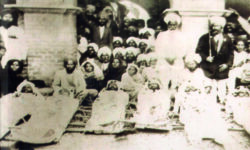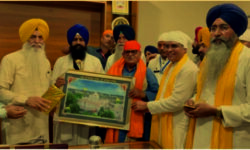By Tania Qureshi
Duleep Singh, the last Maharaja of Punjab, was taken to Britain as a child prisoner under the authority of the East India Company after the end of the Second Anglo-Sikh War and the subsequent occupation of Punjab by Britain on March 29, 1849. He was also kept away from his mother, Rani Jind Kaur, possibly because the British feared the continued power of the Sikhs in Punjab.
When Duleep was finally allowed to meet his mother decades later, he learned about his lost kingdom and religion. He had been converted to Christianity during his childhood and was isolated from his family, people of his faith, and Punjab. This revelation prompted him to reclaim his heritage from British treachery. Throughout his struggle, Duleep married and had six children — three sons and three daughters — in his first marriage.
Princess Bamba Duleep Singh, the eldest daughter of Maharaja Duleep Singh and granddaughter of Maharaja Ranjit Singh, was born on September 29, 1869, in London. Like her father, she was raised as a Christian, and for many years, the British government kept her true ancestry hidden. Unlike her father, who was denied higher education by his British captors, Bamba was allowed to pursue an education and attended Oxford University. Queen Victoria was very kind to her and encouraged her to become a royal socialite.
A true firebrand like her grandfather, Bamba became politically active in England, participating in social movements, including the fight for women’s right to vote. Following in the footsteps of her Sikh ancestors, Bamba decided to visit Punjab after the end of the Raj, when the British could no longer keep the Sikh royal family captive. She hired a Hungarian companion, Marie Antoinette Gottesmann, who later married a Sikh nobleman (and gave birth to the renowned artist Amrita Shergil), before returning to Hungary.
Bamba chose not to return to Britain and instead settled in Lahore — the capital of her father’s usurped Sikh kingdom. She eventually married Dr. David Waters Sutherland, the principal of King Edward Medical College in Lahore. Bamba purchased a house in Model Town, which she named ‘Gulzar.’ There, she cultivated a garden of roses on an area of one kanal (605 square yards). She lived like a commoner in Lahore, the capital of her family’s former empire.
Widowed in 1939 without any children, Bamba died on March 10, 1957. Her funeral was arranged by the United Kingdom Deputy High Commissioner in Lahore, and with only a few people present, she was quietly laid to rest. Though an important historical figure as the descendant of Maharaja Ranjit Singh, she was largely ignored in her later years and did not receive the recognition she deserved. Her grave, located in Gora Kabristan on Jail Road, Lahore, remains relatively unknown and is only decorated with flowers brought by the descendants of Pir Karim Bakhsh from ‘Gulzar.’
Bamba requested the following inscription on her grave:
“The difference between royalty and servility vanishes the moment the writing of destiny is encountered. If one opens the grave of a dead, none will be able to discern rich from poor.”
Princess Bamba left a significant collection of historical items to her secretary, Pir Karim Bakhsh Supra of Lahore. This collection included paintings, artifacts, antiquities, photographs, and other articles. Part of the collection was sold to the Pakistani government and is now on display in the Princess Bamba Sikh Collection inside Lahore Fort, near the curator’s office.
The collection includes extraordinary pictures and paintings of the Sikh Darbar, Maharaja Duleep Singh, Prince Nau Nihal Singh, Maharaja Ranjit Singh, Rani Jindan, Bahadur Shah Zafar, Maharaja Sher Singh’s Council, a sculpture of Ranjit Singh riding an elephant with his entourage, and views of the city on the banks of the River Ravi. These works are truly magnificent, but sadly, they remain hidden from the public eye.
The gallery was once neglected and closed to the public. However, it has recently been reopened by the Archaeology Department for public viewing. The Walled City of Lahore Authority invited a Hungarian art expert, Dr. Zoltán Dragon, PhD, an art historian, to study the paintings in the Sikh Gallery. Dr. Dragon examined paintings such as The Court of Lahore, Duleep Singh, Bahadur Shah Zafar (the last Mughal Emperor), Views of the cities of Calcutta and Benares, Sher Singh, Maharaja Ranjit Singh listening to the Guru Granth Sahib near the Golden Temple, Amritsar, and Sher Singh in Council.
According to Dr. Dragon, the paintings are in an ambivalent condition. Although they are housed in a protected space, they are still exposed to external environmental factors due to gaps in the windows opposite the entrance, which allow wind and extreme temperature fluctuations to affect them. The objects closer to the entrance, which are more effectively protected, are in better condition. For example, Maharaja Ranjit Singh Listening to the Recitation of the Guru Granth Sahib near the Golden Temple, Amritsar and Sher Singh in Council have some minor surface paint losses, and the varnish is discolored. However, the condition of the magnificent Court of Lahore painting is more damaged, partly due to its size, which covers an entire wall. The weight of the canvas has caused the lower third to become loose and cupped, with flaking and paint losses up to 1-2cm in some areas.
It is important to note that the Fort of Lahore houses ten paintings by Ágoston (August) Schoefft, the master of these works. Schoefft created these pieces between 1841 and 1855, based on his travels. His paintings, displayed in Lahore, are historically significant, and his life in Lahore is recorded in literature, including the memoirs of Maharaja Duleep Singh’s physician, Martin Honigberger.
The significance of the collection inherited by Princess Bamba is immense. Previously, the gallery was in poor condition, with no proper descriptions of the items, no lighting, and it was closed to the public. The good news is that it has now been reopened for public viewing. Plans are underway to improve the gallery’s condition and conserve the artifacts. I hope that, in the near future, it will become a popular site for visitors within Lahore Fort.
Many Sikh visitors to Lahore are now being taken to this gallery. I highly recommend that everyone, both Sikhs and non-Sikhs, visit this remarkable collection.









